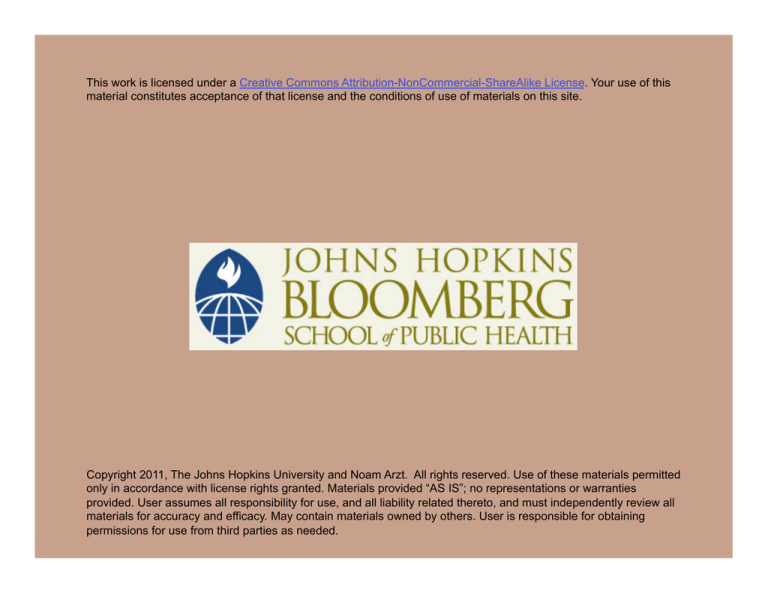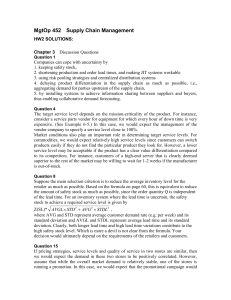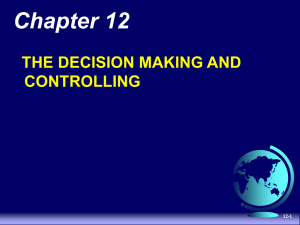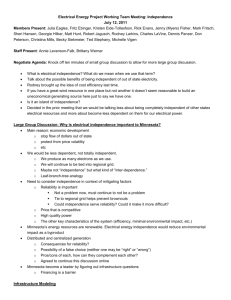
This work is licensed under a Creative Commons Attribution-NonCommercial-ShareAlike License. Your use of this
material constitutes acceptance of that license and the conditions of use of materials on this site.
Copyright 2011, The Johns Hopkins University and Noam Arzt. All rights reserved. Use of these materials permitted
only in accordance with license rights granted. Materials provided “AS IS”; no representations or warranties
provided. User assumes all responsibility for use, and all liability related thereto, and must independently review all
materials for accuracy and efficacy. May contain materials owned by others. User is responsible for obtaining
permissions for use from third parties as needed.
Section B
Systems and Systems Integration
Two Types of Integration
Integrated
system
Forming valid
relationships
between data
sources
Data
integration
Participating data sources
3
Two Types of Integration
Application
integration
Presenting a
unified view of
data to a user
through an
application
User access
through public
healthprovided
application
Integrated
system
User access
through local
application within
the organization
Forming valid
relationships
between data
sources
Data
integration
Participating data sources
4
Case Study #1: NYC MCI
LeadQuest and CIR developed independently
Integrated by sharing a Master Patient Index
Other systems may join in the future
Both data and application integration
5
Case Study #1: NYC MCI
LeadQuest and CIR developed independently
Integrated by sharing a Master Patient Index
Other systems may join in the future
Both data and application integration
6
Improvement in NYC
Table 1. Matching results of the “initial load” data by system
Within
System CIR
Within
System LQ
Between
System MCI
Within &
Between
System CIR,
LQ, & MCI
Pre-MCI, N
2,426,369
2,184,216
4,086,865
4,610,585
Post-MCI, N
2,065,230
2,021,635
2,977,290
2,977,290
Merged, N
361,139
162,581
1,109,575
1,633,295
Merged, %
14.9%
7.4%
27.1%
35.4%
Human review, N
74,798.0
56,747.0
95,886.0
227,431.0
Human review, N
3.1%
2.6%
2.3%
4.9%
Table 2. LQ records merged with CIR or vital records
LQ records
Integration merged with
CIR records,
merges
%
Birth cohort
CIR
LQ
<1996
851,460
1,235,734
494,595
40.0%
1996
157,818
133,368
105,280
78.9%
1997
159,194
126,373
100,336
79.4%
1998
154,415
124,180
99,236
79.9%
1999
146,339
116,795
94,532
80.9%
2000
150,899
107,048
87,802
82.0%
2001
151,601
95,044
79,979
84.1%
2002
148,015
74,892
63,228
84.4%
2003
142,675
7,985
6,437
80.6%
1996-2003
1,210,956
785,685
636,830
81.1%
Source: Tables are from Papadouka, Vikki et al, “Integrating the New York Citywide Immunization Registry and the
Childhood Blood Lead Registry, Journal of Public Health Management and Practice, November 2004 (Supplement), p. S77.
7
Case Study #2: RI KIDSNET
10+ public health
programs share
system
Primary system for
some; others submit
data
Unified interface
(terminal-based →
WWW)
Replaced simple
person matching
algorithm
8
Improvements in RI
Adapted by CTLT from Rhode Island Department of Health, http://cdc.confex.com/cdc/irc2004/techprogram/paper_5997.htm.
9
Enterprise-Wide Integration in Public Health
Three models:
1. Centralized (RI, MO)
2. Cooperative (NYC, UT)
3. Distributed (de facto for most)
Can be implemented agency-wide or on a sub-organizational level
Success will vary by organizational, technical, and process
attributes
10
Models of Enterprise-Wide Integration
Centralized model
Cooperative model
Distributed model
11
Model Comparison: System Features
Factor
Centralized/
Warehouse
Cooperative
Distributed
Strong; COTS or
custom-developed
Not mandated but
may be present
Not usually a strong
feature
Embedded in MPI
and its services
Embedded in MPI
and its services or
offered separately
At best offered in
individual
participating
systems
Easier to maintain
given
centralization of
services
More challenging
given loosely
coupled nature, >
interfaces
In the hands of the
individual system
managers
System
acquisition
style
COTS or customdeveloped
Interfaces tend to
be customdeveloped
Interfaces tend to
be customdeveloped
Support for
analysis
Centralized,
planned
Mixed, but agencywide coordination
Little central
coordination
Use of MPI
Record deduplication
strategy
Security
12
Model Comparison: Organizational Factors
Factor
Political
sponsorship
Centralized/
Warehouse
Strong
Cooperative
Distributed
Conceptual support Passive at best
Less commitment
IT leadership Strong CIO and
mandate
Strong CIO but less
mandate over apps
Central IT primarily
concerned with
infrastructure
IT staff
Strong centralized
staff
Centralized and
distributed staff
Centralized staff
primarily
concerned with
infrastructure
Formal PMO
Essential
Formal methodology essential;
PMO less so
PMO has little
authority if there
at all
Strategy
Centralized,
planned
Mixed, but agencywide coordination
Little central
coordination
Data sharing
laws and
privacy
Must support data
consolidation
Must support
selective consolidation at least
Model can tolerate
less permissive
laws
13
Model Comparison: Process-Related Attributes
Factor
Centralized/
Warehouse
Cooperative
Distributed
Service
delivery
More centralized
delivery model
Either centralized
or distributed
More distributed
delivery model
Technical
standards
enforcement
Easier, as more
effort is central
Moderate, as
Harder, as systems
compliance enables are largely standinteroperability
alone
System
More stable and
requirements clear
Moderately stable
and clear
Less stable and
often unclear
System
Very coordinated
development
coordination
More independent
but can be
coordinated
Largely
independent and
uncoordinated
Technical
Innovation
Moderately
interested
Not very interested
Less interested
14
Model Comparison: Process-Related Attributes
Factor
Centralized/
Warehouse
Cooperative
Distributed
Technical
risk
Fairly high, but so
is potential gain
Moderate
Fairly low, but so
are potential gains
Deployment
timetable
Incremental, but
requires critical
mass to activate
Incremental, but
coordinated
Incremental, little
coordination
System
deployment
style
Tightly-coupled
Loosely coupled
Uncoupled; usually
replicated services
Cost
Higher up-front,
though overall cost
may be lower;
software license
cost may benefit
from centralized
approach
Moderate up-front
cost, though
overall cost usually
higher
Cost widely
distributed so
difficult to track
and understand;
software costs can
be higher though
coordinated
purchasing can help
15
Key Challenges
Central model: security, privacy, and ownership concerns
Distributed model: technical readiness and data use limitations
16







